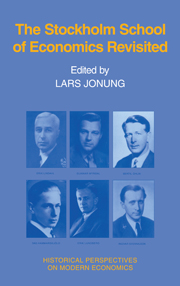Book contents
- Frontmatter
- Dedication
- Contents
- Preface
- List of Contributors
- Dramatis Personae at the end of 1937
- Introduction and Summary
- Part I The roots
- Part II The approach of the Stockholm School
- 4 Expectation and plan: The microeconomics of the Stockholm School
- 5 Sequence analysis and optimization
- 6 There were two Stockholm Schools
- 7 On formal dynamics: From Lundberg to chaos analysis
- 8 Lundberg, Keynes, and the riddles of a general theory
- 9 Macrodynamics and the Stockholm School
- 10 Ohlin and the General Theory
- 11 The monetary economics of the Stockholm School
- Comment
- 12 The Austrians and the Stockholm School: Two failures in the development of modern macroeconomics?
- 13 The political arithmetics of the Stockholm School
- 14 After the Stockholm School
- Part III The impact of the Stockholm School
- Part IV What remains of the Stockholm School?
- The Stockholm School: A non-Swedish bibliography
Comment
Published online by Cambridge University Press: 05 July 2013
- Frontmatter
- Dedication
- Contents
- Preface
- List of Contributors
- Dramatis Personae at the end of 1937
- Introduction and Summary
- Part I The roots
- Part II The approach of the Stockholm School
- 4 Expectation and plan: The microeconomics of the Stockholm School
- 5 Sequence analysis and optimization
- 6 There were two Stockholm Schools
- 7 On formal dynamics: From Lundberg to chaos analysis
- 8 Lundberg, Keynes, and the riddles of a general theory
- 9 Macrodynamics and the Stockholm School
- 10 Ohlin and the General Theory
- 11 The monetary economics of the Stockholm School
- Comment
- 12 The Austrians and the Stockholm School: Two failures in the development of modern macroeconomics?
- 13 The political arithmetics of the Stockholm School
- 14 After the Stockholm School
- Part III The impact of the Stockholm School
- Part IV What remains of the Stockholm School?
- The Stockholm School: A non-Swedish bibliography
Summary
Johan Myhrman is rather critical of the Stockholm School considered as a group of monetary economists, and with one partial exception that I shall note below, I share his qualms. Let it be clear, though, that our doubts arise because we have a particular view about what constitutes “good” monetary economics and a particular view about the historical development of the ideas we find particularly attractive. This view is not one that is universally shared by respectable monetary economists even today, let alone in the 1930s, and so the position Myhrman takes, though eminently defensible, is nevertheless bound to be controversial. It will help to place his work in context if I briefly and explicitly describe the vision of “good” monetary economics that underlies it. Myhrman and I would both, I think, loosely characterise overselves as “quantity theorists,” and by that we would mean the following: that the critical (though not the only) variable to be explained by monetary economics is the general price level, and that pride of place should be given to the quantity of money (suitably defined, and I shall return to this point in a moment) as an explanatory variable here. Moreover, we would both deploy a stock supply and demand apparatus in constructing any explanation of the connection between money and prices. Thus our conception of “good” monetary economics involves some kind of an amalgamation of the best insights of Wicksell and Marshall as developed by, among others, Keynes and Friedman.
- Type
- Chapter
- Information
- The Stockholm School of Economics Revisited , pp. 290 - 294Publisher: Cambridge University PressPrint publication year: 1991

